Nano Fertilizers Market Research, 2033
The global nano fertilizers market was valued at $2.3 billion in 2023, and is projected to reach $8.7 billion by 2033, growing at a CAGR of 14.3% from 2024 to 2033. Nano fertilizers are advanced agricultural inputs formulated using nanotechnology to enhance the efficiency of nutrient delivery to plants. These fertilizers are composed of nanoparticles or nanostructures that provide essential nutrients in a controlled and targeted manner, improving nutrient uptake and minimizing environmental impacts. The nano-scale size of the particles (1-100 nanometers) ensures higher surface area, reactivity, and solubility compared to conventional fertilizers.
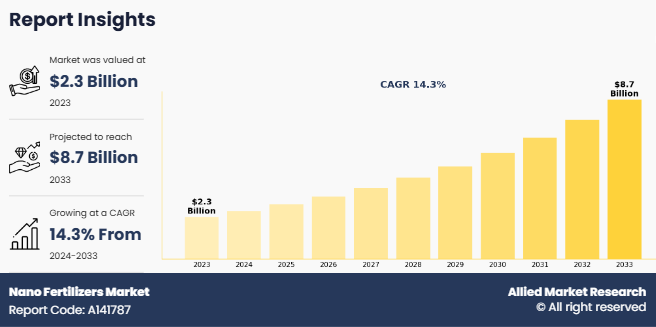
Introduction
Nano fertilizers are extensively used in agricultural systems to increase crop yields and improve soil fertility. They provide essential nutrients such as nitrogen, phosphorus, and potassium in a highly efficient form, ensuring that plants receive the required nutrients without over-application. This targeted delivery system helps mitigate nutrient runoff and leaching, protecting nearby water bodies from contamination.
In horticulture, nano fertilizers are applied to enhance the growth of fruits, vegetables, and ornamental plants. Their precise nutrient delivery supports healthier plant development, and improved resistance to pests and diseases. This is particularly beneficial for high-value crops where quality and yield are critical. Nano fertilizers contribute to environmental sustainability by reducing the carbon footprint associated with traditional fertilizers. They help lower greenhouse gas emissions by decreasing the amount of fertilizer needed per unit of crop yield. In addition, their use minimizes soil and water pollution caused by over-fertilization.
Key Takeaways
- The Nano Fertilizers Industry study covers 20 countries. The research includes a segment analysis of each country in terms of value for the projected period.
- The study integrated high-quality data, professional opinions and analysis, and critical independent perspectives. The research approach is intended to provide a balanced view of global nano fertilizers markets and to assist stakeholders in making educated decisions in order to achieve their most ambitious growth objectives.
- Over 3,700 product literature, annual reports, industry statements, and other comparable materials from major industry participants were reviewed to gain a better understanding of the nano fertilizers market size.
- The key players in the nano fertilizers market share are Indian Farmers Fertiliser Cooperative Limited, Indogulf BioAg LLC, Nanotech-Agri, Ray Nano Science & Research Center, Kanak Biotech, EuroChem Group AG, Lazuriton Nano Biotechnology Co., Ltd., Geolife Agritech India Pvt. Ltd., Coromandel International Ltd., and Aqua Yield Operations, LLC. They have adopted strategies such as acquisition, product launch, merger, and expansion to gain an edge in the market.
Market Dynamics
Increase in demand for agricultural productivity is expected to drive the growth of the nano fertilizer market. The adoption of nano fertilizers, designed at the molecular level to improve nutrient absorption in plants, is driven by the need for increased agricultural productivity. Their tiny particle size ensures efficient delivery of nutrients directly to plant cells, enhancing growth, health, and crop yields. In December 2023, Haryana's Agriculture and Farmers Welfare Department launched an initiative to demonstrate nano urea fertilizer on 100,000 acres during the 2023-24 rabi season. Farmers were encouraged to register on the 'Meri Fasal Mera Byora' portal to participate, highlighting the benefits of nano urea, including higher yields, better crop quality, and reduced environmental impact compared to traditional urea.
However, limited awareness and knowledge of nano fertilizer is expected to hinder the growth of the nano fertilizers market. Limited awareness and understanding among farmers, particularly in rural or developing areas, where traditional farming practices dominate, is a key barrier to the adoption of nano fertilizers. Many farmers lack exposure to the benefits of nano fertilizers, such as improved efficiency, reduced environmental impact, and higher yields. Educational initiatives and awareness campaigns are crucial to address this knowledge gap. Providing farmers with training, demonstrations, and success stories from early adopters can build trust and encourage adoption. However, the lack of sufficient training and information on the proper application of nano fertilizers further hinders their adoption.
Segments Overview
The nano fertilizers market is segmented into raw material, method, application area, and region. On the basis of raw material, the market is divided into nitrogen, silver, carbon, zinc, and others. On the basis of method, the nano fertilizers market is categorized into spray or foliar, and soil treated. On the basis of application area, the market is classified into cereals & grains, oilseeds & pulses, fruits & vegetables, and others. Region-wise, the market is divided into North America, Europe, Asia-Pacific, and LAMEA.
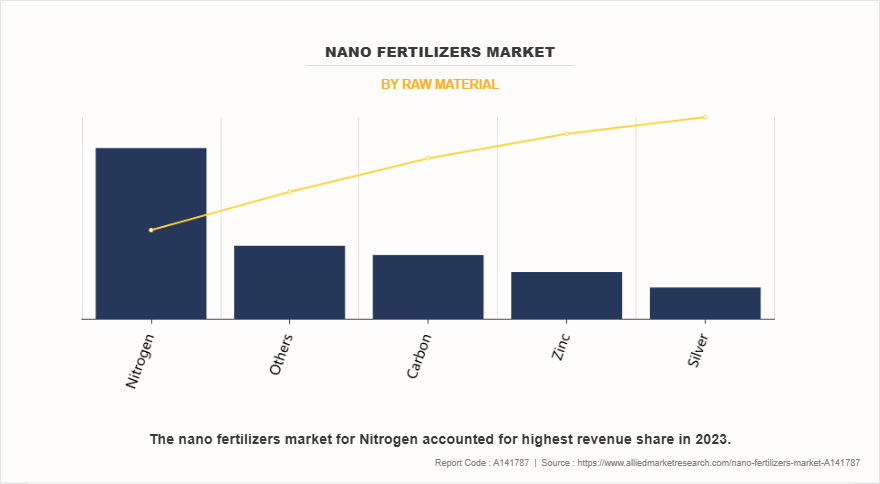
On the basis of raw material, the nitrogen segment dominated the market in 2023 accounting for more than one third of the market share. Nitrogen nano fertilizers are engineered to release nitrogen in a controlled manner, matching the nutrient requirements of plants over an extended period. This controlled-release property reduces the frequency of fertilizer applications and ensures that nitrogen is available when the plants need it the most. In addition, high surface area of nano fertilizers allows for better interaction with plant roots, enhancing absorption rates. This targeted delivery significantly increases nitrogen use efficiency, potentially reducing the amount of fertilizer required while boosting crop yields.
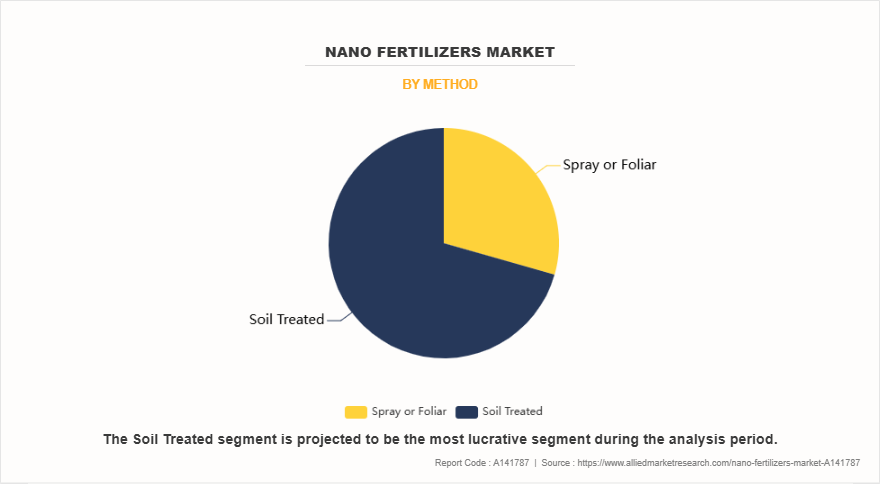
On the basis of method, the soil treated segment dominated the market in 2023 accounting for more than half of the market share. Nano fertilizers represent a transformative approach to sustainable agriculture, offering numerous benefits for soil treatment and crop production. These fertilizers, which are engineered at the nanoscale, have superior properties such as higher nutrient delivery efficiency, targeted nutrient release, and reduced environmental impact as compared to traditional fertilizers. By improving nutrient uptake by plants and minimizing losses due to leaching or volatilization, nano fertilizers contribute to healthier soil ecosystems and enhanced crop yields.
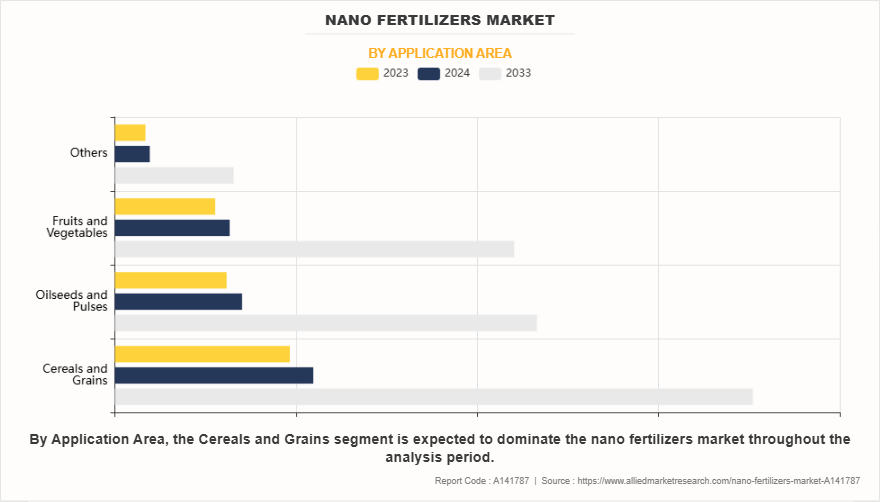
On the basis of application area, the cereals and grains segment dominated the market in 2023, representing the CAGR of 13.9% during the forecast period. Nano fertilizers are emerging as a advancement in agricultural practices, particularly in the cultivation of cereals and grains. These fertilizers, engineered at the nanoscale, offer targeted nutrient delivery, ensuring higher efficiency and minimal environmental impact as compared to conventional fertilizers. For instance, nano-sized formulations of essential nutrients such as nitrogen, phosphorus, and potassium ensure a slow and sustained release, matching the crop's growth cycle. This controlled release reduces nutrient leaching into the environment and ensures that plants receive adequate nutrition at critical growth stages, such as germination, tillering, and grain filling.
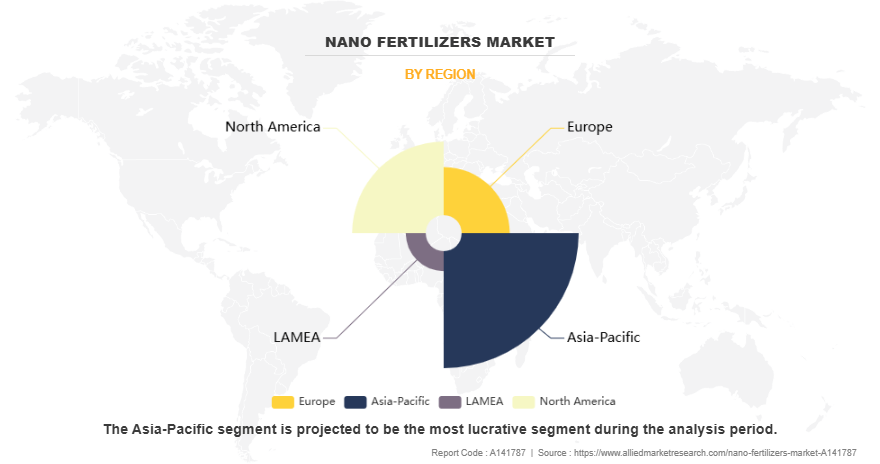
On the basis of region, Asia-Pacific dominated the nano fertilizers market in 2023, accounting for more than one third of the market share. Nano fertilizers are emerging as a solution for enhancing agricultural productivity in the Asia-Pacific region, which is home to some of the world's largest agricultural economies such as India, China, and Indonesia. These fertilizers, designed at the nanoscale, offer significant advantages over conventional fertilizers by improving nutrient delivery efficiency, minimizing wastage, and reducing environmental impact. In countries like India and China, which face challenges such as soil degradation, excessive fertilizer usage, and declining crop yields, nano fertilizers present a promising alternative. Governments and agricultural organizations in these countries are actively promoting the use of nano fertilizers through subsidies, awareness campaigns, and research initiatives.
Competitive Analysis
The major prominent players in the nano fertilizer market analysis across Indian Farmers Fertiliser Cooperative Limited, Indogulf BioAg LLC, Nanotech-Agri, Ray Nano Science & Research Center, Kanak Biotech, EuroChem Group AG, Lazuriton Nano Biotechnology Co., Ltd., Geolife Agritech India Pvt. Ltd., Coromandel International Ltd., and Aqua Yield Operations, LLC. These players have adopted several strategies to make their market position strong.
- In April 2023, the Indian Farmers Fertiliser Cooperative (IFFCO) introduced the world's first Nano DAP Liquid Fertilizer. This innovation is expected to enhance plant productivity, reduce environmental pollution, and decrease dependence on traditional DAP imports. IFFCO has established manufacturing facilities in Kalol and Kandla in Gujarat, and Paradeep in Odisha, with plans to produce 18 crore bottles of Nano DAP by the fiscal year 2025-26.
- In February 2023, Union Minister Mansukh Mandaviya inaugurated IFFCO's two nano urea plants in Uttar Pradesh. He also announced that a government expert panel had approved the launch of nano DAP, highlighting the government's commitment to promoting alternative fertilizers.
Nano fertilizers Industry News
- As of July 2024, the Government of India has notified specifications for Nano Urea and Nano Di-Ammonium Phosphate (DAP) under the Fertilizer Control Order, 1985. Consequently, six Nano Urea plants with an annual capacity of 26.62 crore bottles (500 ml each) and four Nano DAP plants with an annual capacity of 10.74 crore bottles have been established across the country
- In July 2024, the 'Namo Drone Didi' Scheme was launched to provide drones to 15,000 women Self Help Groups (SHGs) for the application of nano fertilizers. As part of this initiative, 1,094 drones have been distributed by fertilizer companies to these SHGs, promoting efficient and precise application of nano fertilizers.
Key Benefits For Stakeholders
- This report provides a quantitative analysis of the market segments, current trends, estimations, and dynamics of the nano fertilizers market analysis from 2023 to 2033 to identify the prevailing nano fertilizers market opportunities.
- The market research is offered along with information related to key drivers, restraints, and opportunities of the nano fertilizers market forecast.
- Porter's five forces analysis highlights the potency of buyers and suppliers to enable stakeholders make profit-oriented business decisions and strengthen their supplier-buyer network.
- In-depth analysis of the nano fertilizers market growth assists to determine the prevailing nano fertilizer market opportunities.
- Major countries in each region are mapped according to their revenue contribution to the global nano fertilizer market.
- Market player positioning facilitates benchmarking and provides a clear understanding of the present position of the nano fertilizer market players.
- The report includes the analysis of the regional as well as global nano fertilizers market trends, key players, market segments, application areas, and market growth strategies.
Nano Fertilizers Market Report Highlights
| Aspects | Details |
| Market Size By 2033 | USD 8.7 billion |
| Growth Rate | CAGR of 14.3% |
| Forecast period | 2023 - 2033 |
| Report Pages | 384 |
| By Raw Material |
|
| By Method |
|
| By Application Area |
|
| By Region |
|
| Key Market Players | Nanotech-Agri, Kanak Biotech, Lazuriton Nano Biotechnology Co., Ltd., EuroChem Group AG, Indogulf BioAg LLC, Indian Farmers Fertiliser Cooperative Limited, Ray Nano Science & Research Center, Aqua Yield Operations, LLC, Geolife Agritech India Pvt. Ltd., Coromandel International Ltd. |
Analyst Review
According to the opinions of various CXOs of leading companies, technological advancements in nanotechnology have significantly accelerated the development of more efficient and targeted nano fertilizers. These innovations have enabled the creation of fertilizers that can deliver nutrients in precise amounts, at the right time, and in the most effective form for plant absorption. One of the key advancements in nanotechnology is the ability to design fertilizers that can be tailored to specific soil and crop needs. Nanomaterials, such as nanoparticles and nanostructured coatings, can be used to encapsulate essential nutrients, protecting them from degradation and loss during application. This encapsulation ensures that nutrients are only released when and where they are needed, minimizing wastage and improving nutrient efficiency, resulting in significant reduction in nutrient runoff, which is a major environmental concern associated with traditional fertilization practices. The Department of Fertilizers is encouraging public sector undertakings like National Fertilizers Limited (NFL) and Rashtriya Chemicals & Fertilizers Limited (RCF) to set up nano urea plants. In addition, the government has launched the 'Namo Drone Didi' Scheme, providing drones to women's Self Help Groups for the application of nano fertilizers, thereby promoting modern agricultural practices.
However, infrastructure challenges are expected to hamper the growth of nano fertilizers market. A major challenge that lies to the adoption of nano fertilizers is lack of sufficient infrastructure in rural and remote areas, which limits their availability and hampers effective distribution. In countries such as China and India lack the necessary transportation networks, storage facilities, and supply chains to efficiently deliver advanced agricultural products like nano fertilizers to farmers. Without proper distribution channels, farmers in remote areas may have limited access to these innovative solutions, despite their potential benefits. Furthermore, absence of proper storage facilities can lead to the degradation of nano fertilizers, as they often require controlled environments to maintain their efficacy. This logistical gap not only restricts the reach of nano fertilizers but also increases the costs of transportation and handling, making them less affordable for farmers in underserved regions.
The key players operating in the nano fertilizers market include Indian Farmers Fertiliser Cooperative Limited, Indogulf BioAg LLC, Nanotech-Agri, Ray Nano Science & Research Center, Kanak Biotech, EuroChem Group AG, Lazuriton Nano Biotechnology Co., Ltd., Geolife Agritech India Pvt. Ltd., Coromandel International Ltd., and Aqua Yield Operations, LLC.
The global nano fertilizers market was valued at $2.3 billion in 2023, and is projected to reach $8.7 billion by 2033, growing at a CAGR of 14.3% from 2024 to 2033.
Asia-Pacific is the largest regional market for nano fertilizers.
Increase in demand for agricultural productivity and increase in demand for nutrient efficiency in farming are the leading drivers of nano fertilizers market.
Increase in demand for organic and precision agriculture are the upcoming trends of nano fertilizers market.
Loading Table Of Content...
Loading Research Methodology...


